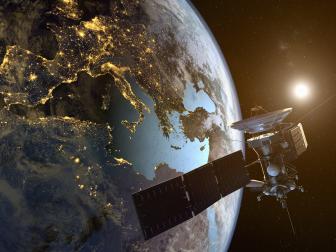
NASA
World Space Week: Satellites Improve Life
World Space Week is an annual event around the globe and observed in over 90 countries. The theme of this year’s celebration is “Satellites Improve Life.” Let’s take a look back at the early history of satellite launches!
On December 6, 1999, the United Nations General Assembly declared October 4 – October 10 as a time to “celebrate the contributions of space science and technology to the betterment of the human condition.” The dates reflect pivotal moments in the history of space exploration. In the era of the Space Race, Sputnik 1 was launched into low Earth orbit on October 4, 1957, and on October 10, 1967, the Outer Space Treaty came into effect. The treaty is a document that reflects the do’s and don’ts of International Space Law. Since the late 1950s to present day, there has been thousands of launches sending satellites into space. Here are some satellite launch highlights focusing on the early days of these remarkable accomplishments.
October 4, 1957: Sputnik 1
Sputnik 1 began the Space Race as the Soviet Union launched the first artificial Earth satellite into low Earth orbit. It was a small sphere with four long antennae. In Russian, Sputnik means “traveling companion.” On Earth, beeping sounds were played over the radio in celebration and as awareness of the Soviet Union’s accomplishment. This accomplishment caused surprise and fear in other nations as they attempted to understand the significance of this event. Sputnik 1 operated in orbit for three weeks before turning dormant. The satellite stayed in space for two months before burning up while reentering Earth’s atmosphere. Sputnik 1’s success was followed with additional launches of the Soviet Sputnik Program.
![Camera: DCS420A Serial #: 420-2040Width: 1524Height: 1012Date: 11/24/97Time: 11:39:45DCS4XX ImageFW Ver: 081596 TIFF ImageLook: Product----------------------Counter: [88]ISO: 100 Aperture: F2.8Shutter: 60 Lens (mm): 28 Exposure: M Program: Po Exp Comp: 0.0Meter area: MtrxFlash sync: NormDrive mode: S Focus mode: S Focus area: WideDistance: 3.4m](http://discovery.sndimg.com/content/dam/images/discovery/fullset/2020/10/2/sputnik_asm.jpg.rend.hgtvcom.861.689.suffix/1601650785667.jpeg)
NASA
January 31, 1958: Explorer 1
Explorer 1 was the first satellite launched into space by the United States. The satellite was designed with a cosmic ray detector to measure radiation within Earth’s orbit. Explorer 1 stopped communicating with NASA on May 23, 1958 in what was known as its last transmission. After more than 58,000 orbits, the satellite reentered Earth’s atmosphere and burned up on March 31, 1970. Explorer 1 set the stage for more Explorer satellites to follow.

NASA/ JPL
The three men responsible for the success of Explorer 1, America's first Earth satellite which was launched January 31, 1958. At left is Dr. William H. Pickering, former director of JPL, which built and operated the satellite. Dr. James A. van Allen, center, of the State University of Iowa, designed and built the instrument on Explorer that discovered the radiation belts which circle the Earth. At right is Dr. Wernher von Braun, leader of the Army's Redstone Arsenal team which built the first stage Redstone rocket that launched Explorer 1.
October 4, 1960: Courier 1B
Courier 1B was the world’s first active repeater communications satellite. It was successfully launched from Cape Canaveral, Florida. The satellite had the capability to receive, transmit, and store 68,000 words per minute. Courier 1B was active for 17 days and completed 228 orbits. This satellite successfully proved that “it could record messages from an Earth station and rebroadcast them.” This was the precursor of the modern communications satellites that currently orbit Earth.
July 10, 1962: Telestar 1
Telestar 1 was “the world’s first active communication satellite, enabling TV programs to be broadcast across the Atlantic.” It was this satellite in particular that broadcasted for the first-time live television images between the United States and Europe. Telestar 1 was active for 7 months. It proved to be a success when people on the other side of the world could see live images of New York City and the Golden Gate Bridge.

NASA/Bell Labs
Developed by Bell Telephone Laboratories for AT&T, Telstar was the world's first active communications satellite and the world's first commercial payload in space. It demonstrated the feasibility of transmitting information via satellite, gained experience in satellite tracking and studied the effect of Van Allen radiation belts on satellite design. The satellite was spin-stabilized to maintain its desired orientation in space. Power to its onboard equipment was provided by a solar array, in conjunction with a battery back-up system.
August 19, 1964: Syncom 3
Syncom 3 was the first geostationary satellite that provided live television coverage of the 1964 Olympic games in Tokyo, Japan. The satellite operated in high orbit. After proving its capability through numerous tests, use of the satellite was discontinued in April 1969.

NASA
December 13, 1975: RCA Satcom
Satcom 1 was a communications satellite. It was “widely used by both cable and broadcast TV networks, allowing for the ground-breaking transmission of early cable television innovators.” It outshined its competitors as it had twice as much communications capacity, which allowed for lower transmission costs.
February 19, 1976: Marisat
The Marisat was the first maritime telecommunications satellite. “It was designed to provide dependable telecommunications for commercial shipping and the U.S. Navy.” The satellite was the first of its series. It was capable of transmitting various types of data to and from ships at sea through selected shore stations.

NASA/Hughes Space and Communications Company
The first commercial mobile communications satellite, Marisat, in 1975, built by Hughes for Comsat and used by both U.S. Navy and merchant marine ships.
Present day, satellites continue to launch around the world thanks to previous successors. Tonight, look up in the night sky as you may just see a satellite pass by!
Satellite Saviors: How Earth-orbiting Sensors Can Help Save the Planet
Making the planet safer with Earth-orbiting technology



















